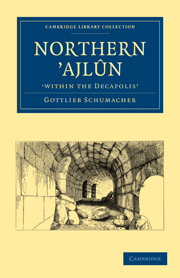Summary
NÂHIYET BENI JUHMA
The area of this Nâhîyet is only partly included in the present Map. Its western part is bounded by the Districts of Es-Siru and El-Wustîyeh; its southern by El-Kûra; its eastern by the Haurân; and its northern again by the Nâhiyet es-Siru. The district occupies a sloping country, having its highest point in the south, in the Jebel ʾAjlûn, from whence it slopes towards the Wâd el-Ghafr. There is a high plateau again to the east beyond Irbid and Beit Râs, from whence the country slopes towards this same wady. The western lands of the district are very little fertile, but the eastern part, in the plain of El-Bukâ'a and the adjacent country to the northward, is almost as fertile as the Southern Haurân country. No large stream is found on the portion figured on the present Map, and to judge from the great reservoirs of the ancient inhabitants found at Irbid and Beit Râs this waterless condition existed in very ancient times. The whole country is perfectly bare of forest or trees.
Principal villages are Irbid, Beit Râs, and Kefr Yûba.
Irbid. —1,733 feet above the sea. The seat of the Kada of Irbid or ʾAjlûn, and the residence of the Kaimakâm, or Lieutenant-Governor.
The village contains about 130 houses and huts, some of them being sufficiently well built. The population is said not to exceed 700 souls. The Serâya, or Governor's house, is a double-winged building, surrounding a large court-yard, and lays claim to no architectural advantages. It is quite modern, and was built to supply the most urgent needs of the officials.
- Type
- Chapter
- Information
- Northern ’Ajlûn, 'within the Decapolis' , pp. 148 - 181Publisher: Cambridge University PressPrint publication year: 2010First published in: 1890

